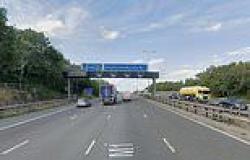By Yuan Ren For Mailonline
Published: 17:29 GMT, 1 March 2019 | Updated: 17:31 GMT, 1 March 2019
View
comments
A Scalextric-like test track using 16 model cars on a miniature highway has been created to make roads of the future more efficient
The self-driving Cambridge Minicar, which is just eight inches long, was designed to create a low cost system to test how autonomous vehicles can work together.
Real life experiments of this type of cooperative driving are expensive, as they require cars operating in a controlled environment with multiple driving lanes.
The miniature system lets researchers test different strategies and smart software, which send signals to the vehicles over radio and internet connections.
Scroll down for video

A Scalextric-like test track using 16 model cars on a miniature highway has been created to make roads of the future more efficient The self-driving Cambridge Minicar was designed to create a low cost system to test how autonomous vehicles can work together
Smart and cooperative driving systems allow automated cars to make decisions like changing lanes rather than waiting in a queue.
A car can communicate this to the other vehicles in the system so that they make adjustments to help individual manoeuvres like that to happen.
Their route planning and navigation system uses an algorithm that relies on positioning feedback from an external motion capture system
The system will also change its behaviour so that it avoids queuing and the group acts towards this goal as a whole.
Using this data, a computer workstation calculates the the velocity and steering control inputs for all vehicles which are relayed to each car over broadband and radio.
Dr Amanda Prorok, whose team at the University of Cambridge developed the Cambridge Minicar system, said: 'Cooperative driving strategies hold a lot of promise for the future of traffic.
'However, more work still needs to be done in order to truly







